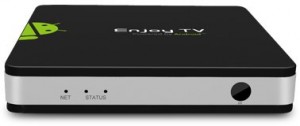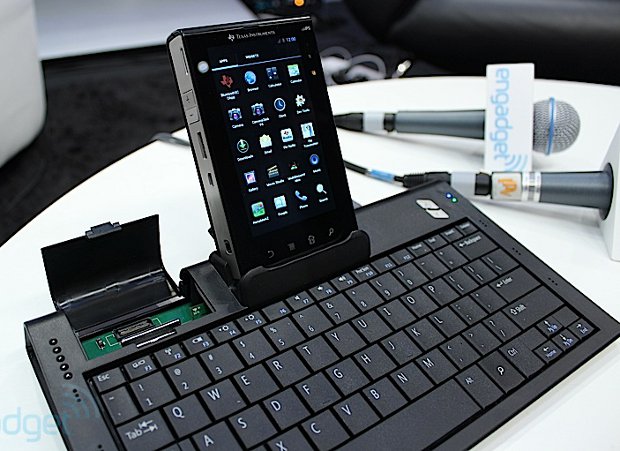I had a VDI image set to 8GB that was nearly full and re-sized it to 16 GB with the following command: “C:\Program Files\Oracle\VirtualBox\VBoxManage.exe” modifyhd “C:\Documents and Settings\Jean-Luc\VirtualBox VMs\Debian 6.0.3\Debian 6.0.3.vdi” –resize 16384 16384 is the new virtual harddisk size in MB (16 GB). This will increase the size of the Virtual disk. However, it won’t increase the size of the partition in your virtual disk. You have then 2 solutions: Create a new partition with the extra free space Use Gparted Live ISO image to increase the size of your current partition.
Ubuntu TV Works on OMAP4 Pandaboard
Ricardo Salveti, Software Engineer at Canonical, has written a blog post saying that Ubuntu TV now support full video hardware acceleration on the Pandaboard, TI OMAP 4 low cost development board. A demo of Ubuntu TV on the ARM platform with Ubuntu TV UI and 720p/1080p video playback can be seen in the video below. Pandaboard is the first ARM platform that can fully run Ubuntu TV. If you have a Pandaboard, you can try it out by installing the packages available at Linaro’s Overlay PPA. Qt and Qtmobility are not there yet (Patches are available at https://github.com/robclark/qtmobility-1.1.0), but he said they would be soon. The source code for Ubuntu TV is available at https://code.launchpad.net/~s-team/ubuntutv/trunk
Installing Emdebian ARM Cross Toolchain in Debian
I had previously installed Sourcery G++ ARM Linux toolchain in Ubuntu to build some software running in Debian, but I encountered some issues with some libraries (libavg) that use gethostbyname in static libraries without any easy way to make it dynamic. In that case, the library in the rootfs and cross-compiler must match. So I decided to install Debian Squeeze (6.0.3) and the corresponding cross-toolchain by Emdebian (short for Embedded Debian). First to use this toolchain, add the URL to get Emdebian packages to /etc/apt/sources.list: # # — Emdebian cross toolchains # deb http://www.emdebian.org/debian/ squeeze main Then install Emdebian public key: apt-get install emdebian-archive-keyring apt-get update If you don’t install the key, you’ll get the following error: W: GPG error: http://www.emdebian.org squeeze Release: The following signatures couldn’t be verified because the public key is not available: NO_PUBKEY B5B7720097BB3B58 Search and install packages for the architecture that you need, in this […]
Geniatech ATV510 Android 4.0 Media Player
Geniatech showcased the TV Box Nano2 ATV510 at CES 2012. This media player is powered by an AMLogic single core Cortex A9 processor (possibly Amlogic AML8726-M) with 512 MB RAM, 2GB Flash and featuring 2 USB ports, 1 microSD slot, a 10/100M Ethernet port and built-in Wifi. The remote, named AiRemote, is an RF remote with accelerometer and gyrometer. The device runs Android 4.0.1, and the company plans to port Google TV 2.0 to their media player soon. This STB should available in Europe and the US in March 2012 at an undisclosed price. Geniatech page for the ATV510 (http://www.geniatech.com/pa/atv510.asp) is currently not working, but you can have a look at the ATV500 running Android 2.3 to get details about the previous model.
Texas Instruments OMAP 5 Reference Design
Texas Instruments announced it was developing the OMAP 5, the first Cortex A15 processor, in February 2012. This year at CES 2012, Texas Instruments unveiled OMAP 5-based reference design / development platform running Android 4.0.1 to Engadget. Remi El-Ouazzane, VP of OMAP at Texas Instruments, explains: “This is the greatest platform on Earth right now… way ahead of Apple, and it’s the first Cortex-A15 (which runs 2x faster than the Cortex-A9) product on the market. When running two Cortex-A15 chips at 800MHz, it’s more or less the same performance as running two Cortex-A9s at 1.5GHz. You’ll see [commercially available products] ramping up with this stuff in late 2012 or early 2013. We are also running Windows 8 on the latest OMAP; it runs perfectly well, and we’ve been working very closely with Microsoft. We’re working on multiple form factors — tablets, thin-and-lights — and we think ARM is going to […]
Google Launches Android Design Website for Developers
Android 4.0 brings quite a few enhancements to the UI framework with new interactions and styles that let developers create Android apps that are simpler and more beautiful than ever before. To help designer and developers produce better looking apps for Android, Google has launched Android Design website, where it is possible to learn about principles, building blocks, and patterns for creating Android user interfaces. The website is divided into 4 main sections: Getting Started Creative Vision Design Principles UI Overview Style Devices and Displays Themes Touch Feedback Metrics and Grids Typography Color Iconography Writing Style Patterns Gesture App Structure Navigation Action Bar Multi-pane Layouts Swipe Views Selection Notifications Compatibility Pure Android Building Blocks Tabs Lists Grid Lists Scrolling Spinners Buttons Text Fields Seek Bars Progress & Activity Switches Dialogs Pickers Google also announced they would be added more resources over time. Visit Android Design website for details.
Parrot AR.Drone 2.0: Linux based Augmented Reality Helicopter
Parrot announced a revised version of its Linux-based Parrot AR Drone “quadricopter” flying drone at CES 2012. The drone can now be operated with any Android device such as smartphones and tablets, whereas the previous version could only be controlled by an iPhone or iPad. Another new software features is the auto-pilot. The quadricopter body has been redesigned and reinforced, and fitted with a new 720p HD front-facing navigational camera which can record video and help the pilot navigating the drone. There is also a vertical camera that was present in the first generation. Here are the technical specializations of the Drone’s motherboard: 1 GHz 32-bit ARM Cortex A8 processor (Maybe OMAP3?) 800Mhz video DSP (TMS320DMC64x) 1GB DDR2 RAM USB 2.0 WiFi b/g/n . 3-axis accelerometer 3-axis gyroscope 3-axis magnetometer Pressure sensor for altitude measurement (altitude > 6m) Ultrasound sensor for ground altitude measurement (lower altitude) 60fps vertical QVGA camera […]
2012 Linux and Android Events by the Linux Foundation
The Linux Foundation has announced the list of events it organizes for 2012. Those are mainly technical, but there is also one event dealing with legal issues. Most of the venues are in the US, with 2 back-to-back events in Europe (Barcelona) and 1 in Asia (Japan). If you are one of the first 50 to register for any LinuxCon event, you can get a 35% discount, by registering with the code “12PM35”. List of Events: Android Builders Summit – February 13-14, 2012, Hotel Sofitel SF Bay, Redwood Shores, Calif. A technical summit for OEMs, their device manufacturers, integrators, custom builders, and the growing Android and Linux Kernel developer communities. Embedded Linux Conference – February 15-17, 2012, Hotel Sofitel SF Bay, Redwood Shores, Calif. The premier vendor-neutral technical conference for companies and developers using Linux in embedded products. Linux Storage, Filesystems and MM Summit – April 1-2, 2012, Hotel Nikko, […]









